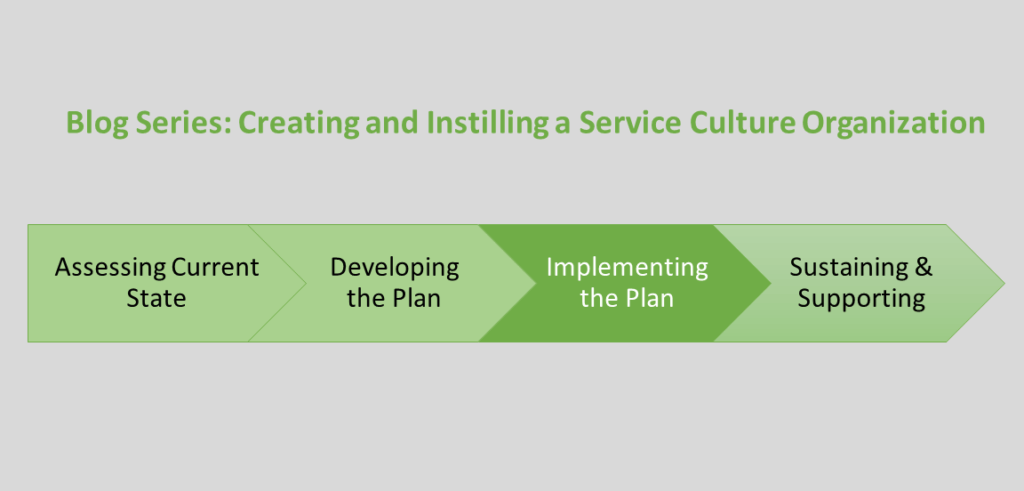
Instilling or re-shaping the service culture of your organization doesn’t happen overnight. In this series we are sharing some tips for creating a plan and a program to support the consistent service culture that you desire throughout your organization. It’s not just about training, as we already discussed in the first two steps where you assess your internal capacity and develop the plan. Once you have determined your approach and developed the plan customized to your organization, then you get to the really fun part – implementing and realizing the plan throughout the organization!
Leaders First
We believe it is essential to take the leaders in your organization through the service culture training program that you plan to roll-out. Not only should they see and experience what their staff will, but they also need advice and support. How will they hold their team accountable to the service standards and expectations? How do they model and set high expectations, and then coach their team to achieve those expectations? We find that after leaders have participated in the same sessions their staff will attend, a session focused on leadership development is essential to make sure that the leaders are all on the same page with how to approach instilling the service culture. It is also wise to include themes that emerged from the service-driven culture assessment referred to in the “Develop the Plan” step.
Finally, it is important that service goals are incorporated into the overall goals and incentives for the organization. With all the competing priorities organizations face today, service must be one of these priorities, and so “hard-wiring” service goals into incentives helps ensure service receives the attention it deserves.
Just a word of caution here: I’ve seen organizations try to skip this step, training thousands of staff members but neglecting the leadership levels, and then wondering why nothing changes. This isn’t something to gloss over. Making sure the leaders and senior leaders are aligned, supportive, and supported in holding the staff accountable is essential.
Ready, Set…Go!
Once the leaders have progressed through your training modules, then it is time to initiate the various training cohorts of staff, physicians, and volunteers. No matter what approach you take in your training sessions, make sure you incorporate various aspects that engage the hearts and minds of the participants. Some of the best sessions incorporate a variety of means including simulation and skills practice opportunities, compelling videos projecting the patient voices, and personal reflection and commitments.
Depending on the pace of your progression, it is also a good idea to develop support materials for leaders as they try to set expectations and help hold their team accountable. If it will take 18 months to 2 years to get your entire organization through the program, what are some foundational things leaders and the patient experience team can begin to do right away?
To Teach or Not to Teach?
Organizations that hire us to come and help them develop their own training program want to make sure that they have a team in-house that can continue to deliver the training when we are gone. There are a variety of train-the-trainer models we employ to help enable the organization’s self-sufficiency. One way is to have our team lead the sessions alone for a period of time to help refine the delivery and the course flow. Then, as trainees are identified, we team teach for a period of time. After that, we match up two trainees to team teach while a member of our team takes on the role of a coach.
At the end of the day, regardless of who leads your service culture training sessions, what’s most important is the passion of the person facilitating the session. I don’t really care about the background of the person who facilitates it provided that they have a great passion for service and are able to translate that into engaging participants!
In the final installment of this series, we will talk about evaluating the progress of your service culture “instillation” as well as some tools and other activities than can help support and reinforce your training efforts.
